

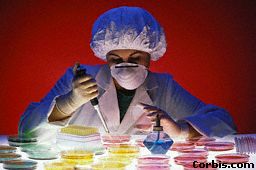
The Forensic Chemist studies the molecular aspect of a crimescene and can match fibers, paint, dyes, etc. to a particular crime scene.
Paint
Paint in any form can be a useful clue in a criminalinvestigation. It can be a chip of dried paint, fresh surface paint, freshpaint smear and so on. When comparing paint specimens, Forensic Chemistusually rely on comparison microscope or a stereoscopic microscope. Forensic Chemist usually search for a physical match with a part of a paintedsurface before doing a chemical analysis. They look for broken edges,scratches, or blemishes on the samples collected. The chemical analysis ofpaint is usually destructive and seldom provides a common source. We usechemical test on paint to identify the type of pigment so that a common origincan be found between the samples. The elements that make up the inorganicpigment of paints can be identified by a variety of techniques including;emission spectroscopy and the neutron activation test. We can also make ananalysis on the texture including; glossiness, granularity, hardness. Wecan also make analysis on the wrinkling property, cracking property, blisteringproperty, and chalking property.
Hair & Fiber
Hair
The first thing we want to determine when examining hair is thefact that it really is hair. We look for the presence of a cuticle,cortex, and medulla. Cuticle. Two of the features that make hair a good subject for establishing identity areits resistance to chemical decomposition and its ability to keep structuralfeatures over along period of time. The cuticle is formed by overlappingscales that always point toward the tip end of each hair. Although thescale pattern is not a useful characteristic for individualizing human hair, thevariety of patterns formed by animal hair makes it an important feature inspecies identification. Cortex. This is made up of spindle-shaped cortical cells that are aligned in a regulararray, parallel to the length of the hair. The major forensic importanceof the cortex is that it is embedded with the pigment granules that impart hairwith color. The color, shape, and distribution of these granules providethe criminalist with important points of comparison between the hairs ofdifferent individuals. Medulla. This is the collection of cells having the appearance of a central canal runningthrough a hair. In animals this is the most predominate feature, occupyingmore than half of the hair's diameter. The second thing we need toestablish is that it is human hair. We do this by looking at the scalepatterns. Thirdly, we determine the race if the hair is human. To dothis we look at three primary races: Caucasian, Negroid, andMongolian. We look at the cortex to determine the differences. InCaucasian the cortex is round and has an even distribution of color, Negroid,there is a ribbon appearance to the cortex and coloring in clumps, Mongolian,the hair is straight and two other color distributions. Thirdly we can determinewhat part of the body the hair came from. To determine this we have totake a cross section of the cuticle. The three parts of the body include:face (triangle shape), head (round shape), pubic (bean shape). We can alsolook at the physical characteristics such as; short mucus clinging (nasal hair),long and kinky with debris (pubic or underarm hair). Other information canalso be determined such as; bleached, dyed, or colored hair, environment,occupation, and hangouts, and certain illnesses.
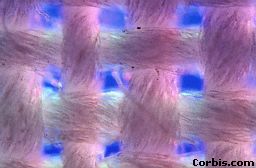
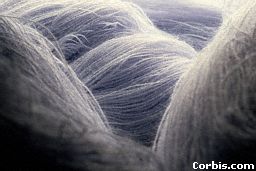
Fibers
Generally fibers are separated into twobroad categories; natural and man-made. We classify fibers into fourgroups; animal, vegetable, minerals, and synthetic. Animalfibers include: furs, wools, silks, horse hairs, and animal hair brushes. Vegetablefibers include: cotton, linens, jute, hemp, and sisal. Also products such as ropes, clothes,paper, and packing materials may fall into this category. Mineralfibers include: asbestos, glass, andfiberglass. Products include: insulation, body repairs, clothing, drapery,safe insulation, and fire proofing. Syntheticfibers include: man-made fibers such asrayon, orlon, nylon, and dacron. These can be found in clothes, drapery,bindings, fishing lines, and hosiery. Physical,chemical, and discernibledifferences are the three types of laboratoryexaminations that can be done on fibers. Physicalexaminations include: determining colors, directionof twist of thread, diameter of the thread, numbers of fibers per ply, number ofply per strand, and the number of strands. Chemicalexaminations include: type of fiber, andanalysis for impurities. When we look for discernible differences we lookat the medulla, cortex, and the cuticle, the way in which the scale patterns areformed, and any effect of fire one the fiber. Animalfibers: there is an identifiable medulla, cortex, andcuticle. Animal hair stops burning when it is removed from the fire andsmells of proteins. Vegetablefibers: there is no medulla or cortex butthere is a definite cellular structure (cuticle). Continues to burn evenafter it is removed from fire and retains its shape after burning. Mineralfibers: there is no visible medulla, cortex, orcellular structure, but there is a crystalline structure when subjected tomicroscopic examination. These fibers do not burn. Syntheticfibers: there is no medulla, cortex, cuticle,or internal cellular structure. Melts before burning.
Glass
Glass is considered to be one of the mostimportant types if evidence overlooked by investigators. Glass isimportant because of three characteristics. Variations in density, refractiveindex, light dispersion characteristics, and element composition analysis. The physical properties of density and refractive index are used mostsuccessfully in characterizing glass particles. When force is used againstglass three types of fractures can be identified: radial, concentric, andconchoidal. Radial fractures are curved lines that meet this side of theglass opposite the destructive force at nearly a right angle. Concentricfractures are lines that form almost right angles with this side on which theforce was acted. Conchoidal fractures start from the edge of the glassopposite the destructive force. Their curved lines form right anglesagainst this side. This fractures aremicroscopic.
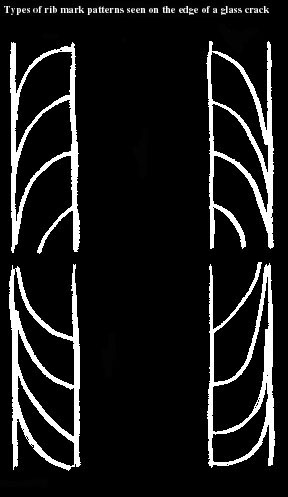
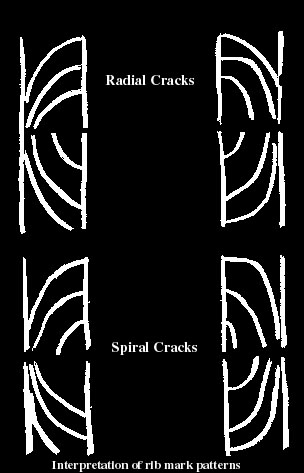
Glass breaks first opposite the side of impact, that is the sideopposite impact bends. The break occurs where the most bending hasoccurred then on the side of impact. There are three types of glassexamination: physical, chemical, and molecular structure. Physicalexaminations include: color, thickness, surface characteristics,and debris. Chemical examinations we look forthe presence of additives such as lead, boron, lime, and cobalt. MolecularStructure we look for Refractive index ( thespeed of light travels through different media) we measure the differences, Densitywhere we basically take the weight of the two pieces while they are suspended inliquids of varying densities, Dispersion where areray of light is projected through the sample, it breaks into a tiny spectrum andwe measure the bands and the widths and see if they match. Another key aspect when examining glass is determining which bullet hole camefirst and the angle of gunfire. In determining which bullet hole was madefirst we will see that the radial fractures will continue until it hits anotherhole, the first bullet hole will have fractures that are uninterrupted, and thesecond will end with the firsts radial and concentric fractures. Whendetermining the angle of gunfire some things that you need to remember are asfollows: a bullet strikes the glass at a right angle and the chippingaround the exit will be evenly distributed, on the right side there is anelliptical hole with little chipping on the right side of exit and considerablechipping on the left side, the more acute the angle the greater thechipping.
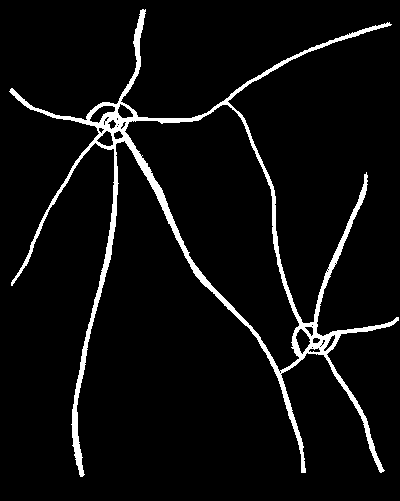
Two bullet holes in a window made atdifferent times. Hole in the lower right was made after that of the upperleft.

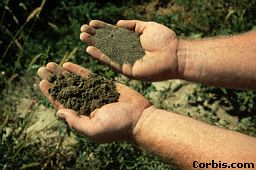
Forensic Geologist can determine where a person or object hasbeen by analyzing soil samples, whether is be a on a pair of shoes, tire treads,or a body. The soil can be matched up with common types and tellspecifically where that person or object has been. Burglary crime scenesseem to be the most common cases in which soil evidence is found. Soil hasbecome an important evidence item to criminalistics because of itsabundance and the ease with which it is transported. Soil is uniquebecause it is composed of decade rock, various minerals, and decomposed plantmatter. The individuality of soil is determined by the degree of humus,minerals, and human-made elements present in a particular sample. The Soildensity gradient test is the most commonly usedmethod for comparing and analyzing soil samples. Comparing samplesvisually for color as well as chemical testing can also be used. Thecriminalist should select six different locations for comparison samples.